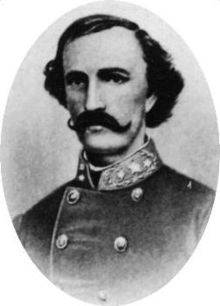1st Arkansas Mounted Rifles
| 1st Arkansas Mounted Rifles | |
|---|---|

Colonel, later General Thomas J. Churchill would serve as the Governor of Arkansas following the American Civil War
|
|
| Active | June 18, 1861–April 26, 1865 |
| Disbanded | April 26, 1865 |
| Country | Confederate States of America |
| Allegiance |
|
| Branch | Mounted infantry |
| Size | Regiment |
| Engagements | |
| Battle honours | Southern Cross of Honor Ten soldiers for the Battle of Murfreesboro |
| Commanders | |
| Notable commanders |
Colonel Thomas J. Churchill General Kirby Smith |
1st Arkansas Mounted Rifles (1861–1865) was a Confederate Army cavalry regiment during the American Civil War. The unit was formed as a mounted infantry regiment, but was dismounted in the spring of 1862 and remained dismounted for the remainder of the war. The unit participated in the earliest battles in the western theater at Wilson's Creek and surrendered with the remnants of the Army of Tennessee in North Carolina in April 1865.
At the outbreak of the Civil War, Arkansas, formed some 48 infantry regiments, and a number of cavalry units. With the exception of the 3rd Arkansas Infantry Regiment, all of the Arkansas units would sign one year enlistments, thus leading to assignments in what was referred to as the "western theater", due to most of the large scale battles being fought in the east. The 1st Arkansas Mounted Rifles would sign one year enlistments, then later would sign a "three year or the duration of the war" extension.
First organized in Little Rock, Arkansas, on June 16, 1861, the regiment was initially commanded by Colonel Thomas J. Churchill. The regiment was composed of the following volunteer companies:
The regiment was first attached to General Benjamin McCulloch's Brigade. By August, they were on the move toward Springfield, Missouri, where they first saw action in the Battle of Wilson's Creek. It reported 45 killed, 161 wounded, and 2 missing at Wilson's Creek. Following that battle, the regiment was dispatched to Indian Territory to battle the Native American pro-Union Cherokee soldiers. They served in that capacity from September through October 1861.
...
Wikipedia
